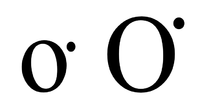O͘

O͘ is one of the six Taiwanese Hokkien vowels as written in the Peh-oe-ji (POJ) orthography. It is a normal o followed by Unicode U+0358 ͘ COMBINING DOT ABOVE RIGHT, and is not to be confused with the Vietnamese Ơ. It is pronounced [ɔ].
This letter is not well-supported by fonts and is often typed as either o· (using the interpunct), o• (using the bullet), oo, or ou.
Because Taiwanese is a tonal language the standard letter without a diacritic represents the vowel in the first tone, the other four possible tone categories require one of the following four tonal symbols to be written above it.
- Ó͘ ó͘ (second tone)
- Ò͘ ò͘ (third tone)
- Ô͘ ô͘ (fifth tone)
- Ǒ͘ ǒ͘ (sixth tone)
- Ō͘ ō͘ (seventh tone)
History
The character was introduced by the Xiamen-based missionary Elihu Doty in the mid-nineteenth century, as a way to distinguish the Minnan vowels /o/ and /ɔ/ (the latter becoming ⟨o͘⟩).[1] Since then it has become established in the Peh-oe-ji orthography, with only occasional deviations early in its usage – one example being Carstairs Douglas's 1873 dictionary, where he replaced the ⟨o͘⟩ with ⟨ø͘⟩ (this letter can be recreated using U+00F8 ø LATIN SMALL LETTER O WITH STROKE and U+0358 ͘ COMBINING DOT ABOVE RIGHT.[2]
References
- ↑ Klöter, Henning. "The History of Peh-oe-ji" (PDF).
- ↑ Douglas, Carstairs (1990) [1873]. Chinese English Dictionary of the Vernacular or Spoken of Amoy. Taipei: Southern Materials Center. ISBN 957-9482-32-2.